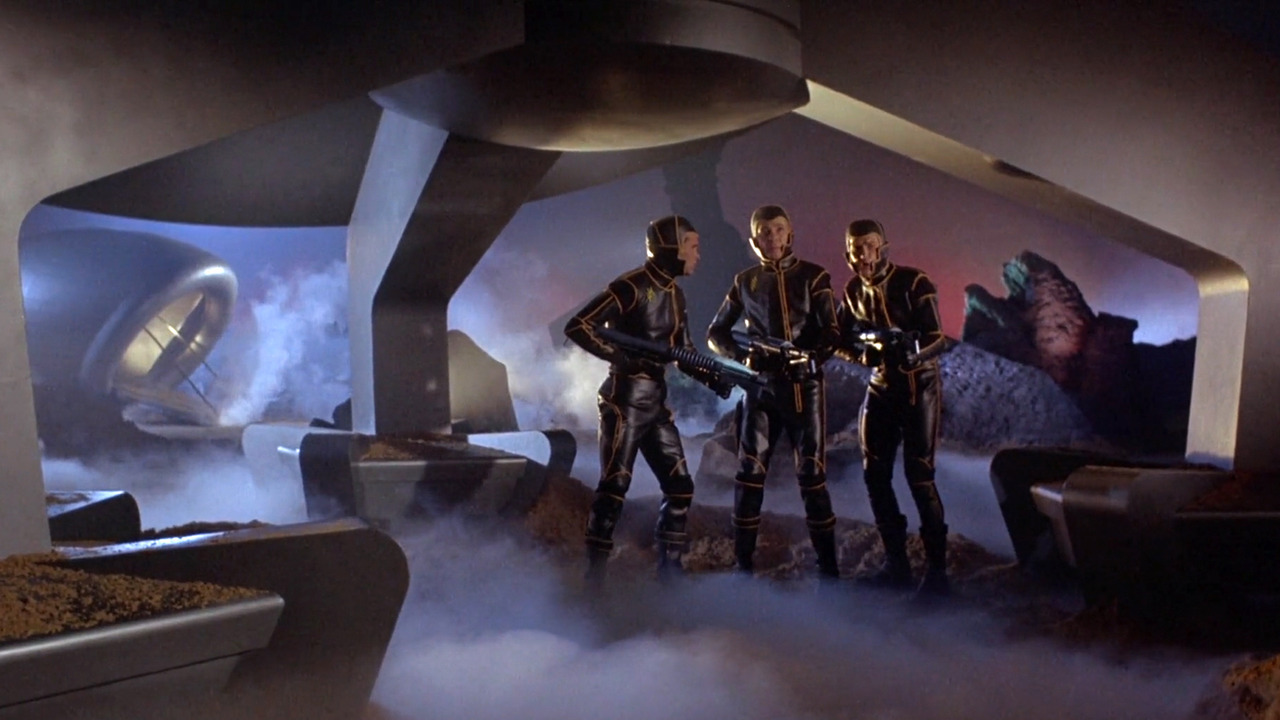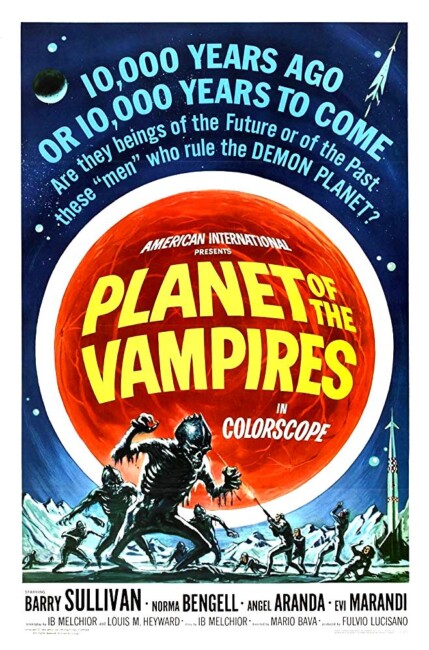aka The Demon Planet; Haunted Planet; Haunted World, Outlawed Planet; Planet of Blood; Planet of Terror; Planet of the Damned; Terror in Outer Space
(Terrore nello Spazio)
Italy. 1965.
Crew
Director – Mario Bava, Screenplay – Mario Bava, Alberto Bevilacqua, Callisto Cosulich, Antonio Roman & Raphael J. Salvia, Story – Ib Melchior, English Language Version Written by Ib Melchior & Louis M. Heyward, Based on the Short Story Un nolte de 21 orc (One Night of 21 Hours) by Renato Pestriniero, Producer – Fulvio Lucisano, Photography – Antonio Rinaldi, Music – Gino Marinuzi Jr & Antonio Perez Olea & (US Version) Kendall Schmidt, Electronic Effects – Paolo Ketoff, Makeup – Amato Garbini, Production Design – Giorgio Giovannini. Production Company – Italian International Film/Castilla Cinematografica.
Cast
Barry Sullivan (Captain Mark Markay), Norma Bengell (Sanya), Angel Aranda (Wess), Fernando Villena (Karan), Evi Marandi (Tiona)
Plot
The crew of the spaceship Argos pick up a distress call from their sister ship Galliott as it is dragged down to a planet’s surface by massive gravitational influence. Moments later, the Argos is drawn down too. When they find the Galliott, it appears the crew have all attacked and killed one another. The bodies of the Galliott crew then rise from their graves, while something takes over the minds of the Argos crew as they sleep. Gradually they come to realize they are being influenced by the alien inhabitants of this world who live on a different vibratory plane and need their bodies in order to escape the planet before the sun goes nova.
The title Planet of the Vampires (the most common of Terrore nello Spazio‘s nine alternate English language titles) is inaccurate – the planet contains no vampires; it should more accurately have been called Planet of the Reanimated Dead or Planet of the Body Snatchers.
Planet of the Vampires marks one of the few occasions when Mario Bava, the cult Italian director of the likes of Black Sunday (1960) and Black Sabbath (1963), strayed into the science-fiction genre. As such, Planet of the Vampires ends up straddling both science-fiction and horror – indeed, it seems to belong more comfortably in the horror genre than within the dictates of science-fiction.
As science-fiction, it is routine – Mario Bava displays no particular flair for its trappings. The plot does not always make sense. Particularly so the ending – it is meant to be a big surprise that the possessed crew discover 20th Century Earth and decide it will be easy to conquer. Confusingly though, the crew (at least those in the English dubbed version) have Earth names like Mark and Toby. The tacked-on scientific jargon is polysyllabic gobbledygook – for some reason, it is necessary for the crew to suppress neural and cortical activity during the landing sequence (which would basically mean having to switch their brains off).
The cast are anonymous – none play with any conviction and decked out in their identical black vinyl uniforms with absurd high collars where it becomes difficult to tell them one from another. The model work of the spaceships is particularly poor and unconvincing.

Mario Bava’s forte as a director was an eerie and ornate Gothicism. Planet of the Vampires has a minor reputation for its atmosphere in some quarters, although this is something that has been over-rated. Some of the scenes with black-uniformed bodies rising up out of their graves still wrapped in plastic are spooky. Mario Bava manages an enormous amount on a tiny budget by creating an alien world out of nothing except polystyrene and his familiar lurid red and orange lighting effects that turn the world almost into a sort of tatty carnival representation of the Inferno. However, there is a certain stockiness to the rest of the action that deadens the atmosphere. Nevertheless, the very coldness of the film and its distance from the presentation of anyone remotely human gives it a dread irrevocability that sinks into the dreaming unconscious the way the best of the 1950s paranoia/takeover films do.
The finest moment that Mario Bava manages is the entry into the alien vessel. When people, and, particularly the video release of the film, call Planet of the Vampires “the film that inspired Alien (1979)”, this is the scene they mean. The alien ship is a vast artifact of unusual architecture, circular corridors, with giant (and very convincing) alien skeletons rotting in the midst of it amid floating CO2 mist, which make for one moment of florid imagination where Mario Bava’s Gothic sensibility and a true sense of the alien meet.
Mario Bava’s other films are uncredited co-direction of Riccardo Freda’s I Vampiri (1957); the Gothic classic Black Sunday/The Mask of the Demon/The Revenge of the Vampire Woman (1960); the Greek muscleman fantasy Hercules in the Center of the Earth/Hercules vs the Vampires (1961); the giallo The Evil Eye (1962); the anthology Black Sabbath (1963): the Gothic horror Night is the Phantom/The Whip and the Body/What? (1963); the giallo Blood and Black Lace (1964) the Gothic Kill Baby … Kill/Curse of the Dead/Curse of the Living Dead/Operation Fear (1965); the spy comedy Dr Goldfoot and the Girls Bombs (1966), Bava’s worst film; the masked super-thief film Danger Diabolik (1967); the giallo Five Dolls for an August Moon (1970); the giallo Hatchet for a Honeymoon/Blood Brides (1971); the giallo Twitch of the Death Nerve/Bloodbath/A Bay of Blood/Carnage/Ecology for a Crime (1971); the Gothic Baron Blood (1972); the giallo/haunted house film Lisa and the Devil/House of Exorcism (1972); and the possession film Schock/Beyond the Door II (1977).
Trailer here


